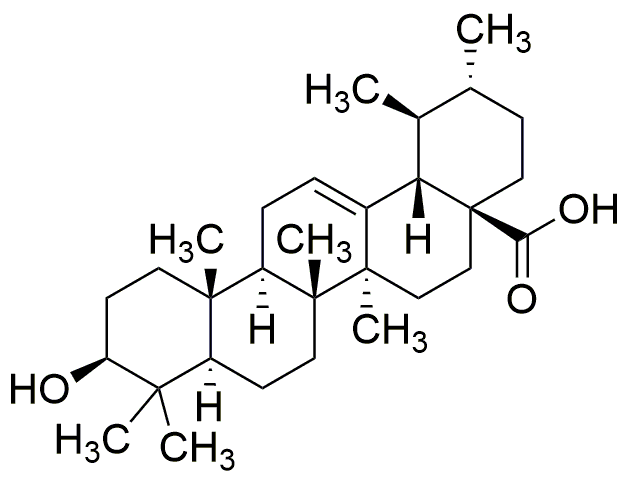Ursolic acid is widely utilized in research focused on:
- Pharmaceutical Development: It is known for its anti-inflammatory and anti-cancer properties, making it a valuable compound in the development of new drugs aimed at treating various diseases.
- Cosmetic Formulations: Due to its antioxidant properties, it is commonly included in skincare products to help protect the skin from damage and promote a youthful appearance.
- Food Industry: As a natural preservative, it helps extend the shelf life of food products while also providing health benefits, such as improving digestion and boosting immunity.
- Herbal Supplements: Ursolic acid is often extracted from plants and used in dietary supplements for its potential to enhance muscle growth and fat loss, appealing to fitness enthusiasts.
- Agricultural Applications: It serves as a natural pesticide, helping to protect crops from pests and diseases while being environmentally friendly compared to synthetic alternatives.
General Information
Properties
Safety and Regulations
Applications
Ursolic acid is widely utilized in research focused on:
- Pharmaceutical Development: It is known for its anti-inflammatory and anti-cancer properties, making it a valuable compound in the development of new drugs aimed at treating various diseases.
- Cosmetic Formulations: Due to its antioxidant properties, it is commonly included in skincare products to help protect the skin from damage and promote a youthful appearance.
- Food Industry: As a natural preservative, it helps extend the shelf life of food products while also providing health benefits, such as improving digestion and boosting immunity.
- Herbal Supplements: Ursolic acid is often extracted from plants and used in dietary supplements for its potential to enhance muscle growth and fat loss, appealing to fitness enthusiasts.
- Agricultural Applications: It serves as a natural pesticide, helping to protect crops from pests and diseases while being environmentally friendly compared to synthetic alternatives.
Documents
Safety Data Sheets (SDS)
The SDS provides comprehensive safety information on handling, storage, and disposal of the product.
Product Specification (PS)
The PS provides a comprehensive breakdown of the product’s properties, including chemical composition, physical state, purity, and storage requirements. It also details acceptable quality ranges and the product's intended applications.
Certificates of Analysis (COA)
Search for Certificates of Analysis (COA) by entering the products Lot Number. Lot and Batch Numbers can be found on a product’s label following the words ‘Lot’ or ‘Batch’.
*Catalog Number
*Lot Number
Certificates Of Origin (COO)
This COO confirms the country where the product was manufactured, and also details the materials and components used in it and whether it is derived from natural, synthetic, or other specific sources. This certificate may be required for customs, trade, and regulatory compliance.
*Catalog Number
*Lot Number
Safety Data Sheets (SDS)
The SDS provides comprehensive safety information on handling, storage, and disposal of the product.
DownloadProduct Specification (PS)
The PS provides a comprehensive breakdown of the product’s properties, including chemical composition, physical state, purity, and storage requirements. It also details acceptable quality ranges and the product's intended applications.
DownloadCertificates of Analysis (COA)
Search for Certificates of Analysis (COA) by entering the products Lot Number. Lot and Batch Numbers can be found on a product’s label following the words ‘Lot’ or ‘Batch’.
*Catalog Number
*Lot Number
Certificates Of Origin (COO)
This COO confirms the country where the product was manufactured, and also details the materials and components used in it and whether it is derived from natural, synthetic, or other specific sources. This certificate may be required for customs, trade, and regulatory compliance.


